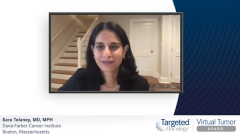
Case 2: Later-Line Treatment of HER2+ Breast Cancer
Episodes in this series

Ruta Rao, MD: Let’s get back to your case, Dr Jhaveri.
Komal Jhaveri, MD, FACP: This patient received THP [taxane, trastuzumab, pertuzumab] for 6 cycles followed by maintenance. This was something that we had done in the CLEOPATRA trial where patients would get their chemotherapy initially, and once they have maximum response or 6 to 8 cycles, we could drop off the chemotherapy backbone and continue their maintenance HP [trastuzumab, pertuzumab]. She had a great partial response in the breast and had complete response in her liver lesions. However, 18 months later, systemic staging done to look at response showed 3 new liver lesions, and the largest this time measured 1.5 cm.
Ruta Rao, MD: At this point, what are your next steps for this patient?
Komal Jhaveri, MD, FACP: In the second-line setting, we have approval for T-DM1 [trastuzumab emtansine] based on the phase 3 EMILIA trial that we were talking about. That was compared with our standard at the time, which was lapatinib plus capecitabine, and these were not patients who had seen prior pertuzumab. They don’t necessarily fall into this patient population particularly, but that’s what we deal with in clinic, and that’s what we’ve been doing in clinic with patients who have progressed on a THP [taxane, trastuzumab, pertuzumab]–based regimen. We offer them second-line T-DM1 [trastuzumab emtansine]–based therapy based on the progression-free survival [PFS] and overall survival benefit seen with T-DM1 [trastuzumab emtansine]–in the second-line setting. This is what I would offer the patient at this point.
Ruta Rao, MD: Back to your case.
Komal Jhaveri, MD, FACP: This patient received standard-of-care T-DM1 [trastuzumab emtansine]. I want to make a plug for 1 of the clinical trials that is available. We are looking at 2 clinical trials in the second-line space, so the treatment landscape continues to evolve. It’s an embarrassment of riches. We’ve had 3 new approvals this year alone for anti-HER2 [human epidermal growth factor receptor 2]–based therapies, and we’re now trying to see how we can further optimize outcomes for our patients. There are 2 attempts. The first is looking at T-DM1 [trastuzumab emtansine] compared with trastuzumab deruxtecan, and we’ll talk about those agents in the second-line setting. Second, we’re also looking at the combination of tucatinib with T-DM1 [trastuzumab emtansine] compared with T-DM1 [trastuzumab emtansine] alone in the second-line setting. We did not have that trial opened at the time, otherwise that would be a good option to offer these patients.
This patient received the standard of care T-DM1 [trastuzumab emtansine] and achieved partial response in both her breast mass and her liver lesions, and she stayed on this therapy for about a year, after which there was progression in her liver. She was also found to have 2 brain metastases at that time; the largest brain lesion was about 2.1 cm in the frontal lobe. She then underwent stereotactic radiation surgery for both these brain lesions.
Ruta Rao, MD: At this point, you have a patient who has progression systemically in her liver as well as the new development of brain metastases, which has been treated locally. At this point, what therapeutic options are you going to consider? As you mentioned, the newly approved regimen in the HER2-positive metastatic breast cancer setting, can you talk about how you think about these new data, including what was presented at ASCO [the American Society of Clinical Oncology Annual Meeting] 2020 in terms of individualizing the treatment selection and the sequencing of our available therapies.
Komal Jhaveri, MD, FACP: We definitely have a good problem with trying to think about the best way of treating patients and what therapy to best apply to this patient. The short answer is that we have a few good options, and the 2 good ones that come to mind directly are, No. 1, a regimen with trastuzumab deruxtecan. This was based on a phase 2 trial with this novel antibody-drug conjugate. The payload is rather distinct from what we have with T-DM1 [trastuzumab emtansine], which is an antimicrotubular agent, and trastuzumab deruxtecan, we have a TOP1 inhibitor payload. We have a cleavable linker, and the drug-to-antibody ratio that we see is almost double of what we see with T-DM1 [trastuzumab emtansine].
We’ve been able to see exciting results with this agent in this phase 2 trial; patients who had a median of 6 prior lines of therapy had a 16-month progression-free survival. The median progression-free survival was 16 months, and the median duration of response if the patient stayed on this therapy was also about 15 months. The disease control rate was about 98%. It has exciting efficacy data across all the efficacy end points that were evaluated on this trial.
The 1 thing we did see with this study was a 14% rate of interstitial lung disease [ILD] and pneumonitis, and that was even fatal in certain patients. This is something we have now become very cognizant about with multiple therapies. We had initially seen that with everolimus in hormone receptor–positive disease. We then quickly learned about management of pneumonitis and many other –itis-like presentations when we had checkpoint inhibitors that were approved in triple-negative breast cancer and other cancers. We have seen that more with antibody-drug conjugates, specifically with trastuzumab deruxtecan. That’s 1 option with those important adverse effects that we have to keep in mind. Patients also get some alopecia, neutropenia, and nausea with this agent as well. That’s 1 option we can think about given the exciting efficacy and bearing these toxicities in mind.
The second option that one could think about would be a combination of tucatinib with trastuzumab and capecitabine based on the exciting data from the HER2CLIMB clinical trial. The initial results were already presented and showed that this triplet met the primary end point of progression-free survival, and we have also heard about exciting data presented at ASCO this year by Nancy Lin. She presented the data on patients with brain metastases who were enrolled on this study. This study had a requirement that all patients undergo a baseline MRI at the time of screening and for eligibility reasons. With the brain MRI done, patients who were already treated for brain metastases were labeled as stable brain metastases patients. Eligible patients who were untreated were either newly diagnosed based on their brain MRI but did not warrant immediate local therapy requirements, or they were patients who had prior radiation but had progressing brain lesions that did not require any local intervention right away. There was a huge effort in that regard on this study, which was commendable and good for our patients.
In that trial with this specific subgroup, we saw a significant improvement in progression-free survival; both intracranial progression-free survival and the overall survival end points were also met. This is exciting for our patients not just with stable brain metastases but also those with active brain metastases or progressing brain metastases.
The overall population had a PFS of about 7.8 months. It was something that we’ve seen in the third-line-and-beyond setting. We’ve seen that with T-DM1 [trastuzumab emtansine] in the TH3RESA trial with a median PFS of about 6 months, and we’ve seen that with the phase 3 SOPHIA trial with margetuximab. We’ve seen a PFS of about 6 to 8 months in the third-line setting. That’s where trastuzumab deruxtecan stands out in terms of PFS, at least in this straight phase 2 open-label trial, and we await the registration of phase 3 randomized data. What we don’t have from the trastuzumab deruxtecan data are the overall survival mature data, and we eagerly await that to make a compelling case for that. There were some data on the stable brain metastases patients that was presented at ESMO [European Society for Medical Oncology Congress] from the study with trastuzumab deruxtecan, where we did see some activity. Those patients continue to benefit systematically with stable brain metastases. It is not a robust cohort or as big a cohort as in the HER2CLIMB study, and it was not a randomized trial, but there was some hint of activity there, which is something we can discuss.
At this point with this patient, it would be important to discuss both of these options, to review the data with her, and to consider either option. An oral-based therapy during COVID-19 [coronavirus disease 2020] makes it easier. It has a good toxicity profile, and not having to worry about ILD and pneumonitis makes a compelling case during COVID-19. It’s something we need to discuss with our patients. Both are reasonable options, and both can be discussed well with our patients.
Transcript edited for clarity.














































